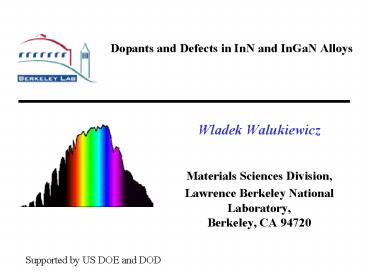Dopants and Defects in InN and InGaN Alloys - PowerPoint PPT Presentation
1 / 25
Title:
Dopants and Defects in InN and InGaN Alloys
Description:
Single Phase Wurtzite Structure No In Clusters. g = (0002) g ... shows only the wurtzite structure. InN pattern with no evidence of. any secondary phase. ... – PowerPoint PPT presentation
Number of Views:157
Avg rating:3.0/5.0
Title: Dopants and Defects in InN and InGaN Alloys
1
Dopants and Defects in InN and InGaN Alloys
- Wladek Walukiewicz
- Materials Sciences Division,
- Lawrence Berkeley National Laboratory,
- Berkeley, CA 94720
Supported by US DOE and DOD
2
Fundamental Band Gap of InN
InN
MBE grown samples show strong PL and
well-resolved absorption edge at about 0.7
eV. Very smooth absorption curve no resonances,
no additional edges at higher energies. No
excitonic enhancement of the absorption edge
3
Selected area electron diffraction shows only the
wurtzite structure InN pattern with no evidence
of any secondary phase. Stoichiometric from
Rutherford Backscattering (RBS)
4
In1-xGaxN Alloys
- Small bowing parameter in In1-xGaxN b 1.43 eV
- The bandgap of this ternary system ranges from
the infrared to the ultraviolet region!
5
Potential Applications Full Solar Spectrum
Photovoltaic Materials
- The direct energy gap of InGaN spans nearly the
entire energy range of the solar spectrum. - Multijunction solar cell based on this single
ternary system could have higher energy
efficiencies. - Advantages of using InGaN
- Flexibility in choosing the number and the
bandgaps of the constituent junctions to optimize
the solar cell performance. - Fabrication process could be greatly simplified
when only one single alloy system is involved. - Graded-bandgap solar cells?
6
Space Applications Irradiation Effects
Van Allen belts High density of electrons and
protons, up to 108 cm-2s-1 Energies from keV to
hundreds of MeV
Extremely hostile environment
7
High Energy Particle Irradiation
Kirtland AFB Dynamitron 1 MeV electrons up to
1x1017 cm-2 LBNL van de Graaf accelerator 2 MeV
protons up to 2x1015 cm-2 2 MeV He up to 2x1015
cm-2 NRL model used to put electron, proton, and
alpha irradiation on same scale Non-ionizing
energy loss (NIEL) and displacement damage dose
(Dd)
8
Effect of Irradiation on Photoluminescence
Intensity
9
Origin of the Radiation Resistance
InN has electron affinity of 5.7 eV, larger than
any other semiconductor Fermi level
stabilization energy, EFS (average energy of
dangling bonds) is located well above the
conduction band edge Defects located in the
band gap are effective as non- radiative
recombination centers
10
Irradition Model
irradiated EF at 0.9 eV above CBM Eglt0.7
as-grown Eg0.7
EF
CB
1.1 eV
CB
0.7
VB
VB
Irradiation with alpha particles creates
N-vacancy defects with an energy level in the
CB Donor-like defects result in conduction band
filling -- all the way up to EFS Extra
conduction electrons provide greater electronic
screening (0.2 eV) and exchange energy
(0.2 eV) resulting in a bandgap narrowing
11
Effect of Irradiation on Electron Concentration
Electron concentration saturates when Fermi level
reaches EFS
12
Irradiation-Induced Stabilization of EF
with EFEFS
13
Electron Mobility
Mobility well explained with Coulomb
scattering by double charged donor defects (VN
?). Onset of resonant scattering for the Fermi
energy approaching the defect energy level
- starting material
14
ECV measurementsSurface accumulation layer in InN
- Independent of bulk electron concentration,
surface electron concentration is mid-1020 cm-3 - Surface accumulation region, 4-8 nm thick
- Surface electron density 2x1013 cm-2
- Consistent with Fermi level pinning at 1 eV
above the CBM.
15
Burstein-Moss Shift in Thin InN
In very thin samples the electron concentration
and Fermi energy are determined by the surface
accumulation with n 4x1020 cm-3 Burstein-Moss
shifted absorption edge at 1.7 eV
16
Accumulation Layer in p-type InN
The thin n-type inversion layer on the
surface determines the Hall conductivity
17
Evidence for p-type InN Electrochemical C-V
- Type change observed below surface in InN doped
with Mg - Surface is n-type but bulk appears to be p-type
18
Irradiation-Induced Type Conversion in p-type InN
Irradiation produces donor defects that
compensate Mg acceptors converting the bulk of
the layers from p- to n-type. Provides strong
support for an existence of p-type conducting
layer in the bulk
19
Burstein-Moss Shift in Irradiated InN
20
Outlook
- Surface electron accumulation
- Surface modification
- chemical treatments
- grazing angle sputtering
- Heterointerface with a large work function
semiconductor e. g. p-type CuInS2 - Composition graded GaInN p/n junction
21
Acknowledgments
- Collaborators
- J. Wu, K. M. Yu, X. Li, R. Jones W. Shan, J. W.
Ager, E. E. Haller, Z. Liliental-Weber and J.
Denlinger - Lawrence Berkeley National Laboratory,
- University of California at Berkeley
- W. Schaff and H. Lu, Cornell University
- A. Cartwright, University of Buffalo
- US Department of Energy
- NRO Director Innovative Initiative
22
Unintentional Doping with O and H
Concentrations of O and H smaller than free
electron concentration.
23
X-Ray Diffraction
30 40 50 60 70
80
2-theta (0)
24
Transmission Electron Microscopy
200 nm
25
Optical Absorption and Photoluminescence































